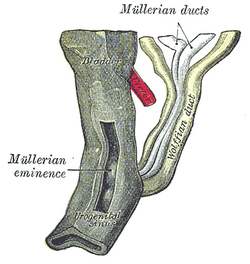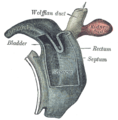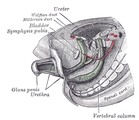Mesonephric duct
| Mesonephric duct | |
|---|---|
 Urogenital sinusof female humanembryoof eight and a half to nine weeks old | |
| Details | |
| Carnegie stage | 11 |
| Days | 28 |
| Precursor | Intermediate mesoderm |
| Gives rise to | Vasa deferentia,seminal vesicles,epididymides,Gartner's duct |
| Identifiers | |
| Latin | ductus mesonephricus; ductus Wolffi |
| MeSH | D014928 |
| TE | duct_by_E5.6.2.0.0.0.4 E5.6.2.0.0.0.4 |
| Anatomical terminology | |
Themesonephric duct,also known as theWolffian duct,archinephric duct,Leydig's ductornephric duct,is a pairedorganthat develops in the early stages ofembryonic developmentin humans and other mammals. It is an important structure that plays a critical role in the formation ofmale reproductive organs.The duct is named afterCaspar Friedrich Wolff,a Germanphysiologistandembryologistwho first described it in 1759.[1]
During embryonic development, the mesonephric ducts form as a part of theurogenital system.[2]
Structure
[edit]The mesonephric duct connects the primitive kidney, themesonephros,to thecloaca.It also serves as theprimordiumfor maleurogenitalstructures including theepididymides,vasa deferentia,andseminal vesicles.
Development
[edit]In both males and females, the mesonephric ducts develop into thetrigone of urinary bladder,a part of the bladder wall, but the sexes differentiate in other ways during development of theurinaryandreproductiveorgans.
Male
[edit]In amale,they develop into a system of connected organs between theefferent ductsof thetestisand the prostate, namely theepididymis,thevas deferens,and theseminal vesicle.Theprostateforms from theurogenital sinusand the efferent ducts form from themesonephric tubules.
For this, it is critical that the ducts are exposed totestosteroneduringembryogenesis.Testosterone binds to and activatesandrogen receptor,affecting intracellular signals and modifying the expression of numerous genes.[3]
In the mature male, the function of this system is to store and maturesperm,and provide accessorysemenfluid.
Female
[edit]In thefemale,with the absence ofanti-Müllerian hormonesecretion by theSertoli cellsand subsequent Müllerianapoptosis,the mesonephric ducts regress, although inclusions may persist. The vestigialepoophoronarises from these ducts. Also, lateral to the wall of the vagina, aGartner's ductcould develop as a remnant.
Function
[edit]Sexual differentiation
[edit]History
[edit]It is named afterCaspar Friedrich Wolffwho described themesonephrosand its ducts in hisdissertationin 1759.[1]
Additional images
[edit]
-
Diagram of a transverse section, showing the mode of formation of the amnion in the chick
-
Reconstruction of a human embryo of 17 mm
-
Cloaca of human embryo from twenty-five to twenty-seven days old
-
Tail end of human embryo thirty-two to thirty-three days old
-
Tail end of human embryo; from eight and a half to nine weeks old
See also
[edit]- Fetal genital development
- List of homologues of the human reproductive system
- Masculinization
- Müllerian duct
- Sexual differentiation
References
[edit]- ^absynd/2845atWho Named It?
- ^Du, Hongling; Taylor, Hugh S. (January 1, 2015)."Chapter 27 - Development of the Genital System".In Moody, Sally A. (ed.).Principles of Developmental Genetics(Second ed.). Academic Press. pp. 487–504.doi:10.1016/b978-0-12-405945-0.00027-2.ISBN9780124059450– via ScienceDirect.
- ^Hannema SE, Print CG, Charnock-Jones DS, Coleman N, Hughes IA (2006). "Changes in gene expression during Wolffian duct development".Horm. Res.65(4): 200–9.doi:10.1159/000092408.PMID16567946.S2CID2444520.





